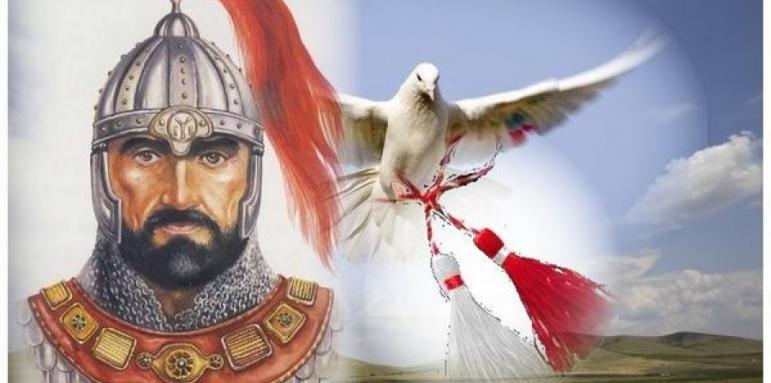Bulgarians Celebrate Baba Marta who brings the End of the Cold and the Beginning of Spring
Culture | March 1, 2023, Wednesday // 10:00| views
@Wikimedia Commons
Every year on March 1, Bulgarians put on themselves and gift their close ones white and red martenitsi. For health, for joy and with a premonition of the end of winter and the arrival of spring. Hardly anyone can say how ancient this Bulgarian tradition is.
According to an old legend, the martenitsi were worn in the Bulgarian lands by the Thracians. They wore martenitsi during the spring mysteries, which symbolized the end of the cold and the awakening of nature to new life. Orpheus himself put martenitsi on his lyre. According to the ancients, it symbolized the infinity of life and the immortality of the human spirit precisely in the combination between the white and the red string.

A more recent legend connects the martenitsa with the arrival of the Asparuh Bulgarians on the Balkan Peninsula. These legends are not one and two. When the proto-Bulgarians reached the Danube plain, they were enchanted by its beauty. They chose this place to light a heathen fire. They believed that around the fire, the god Tangra chooses those who will be under his protection. A celebration began. Many people gathered. They brought fruits and vegetables, animals. The women baked bread, and the men tended the fire and turned large pieces of meat on skewers. There was bread and meat for everyone. The flames of the fire rose higher and higher. Only the khan was not cheerful. He did not have the herb that grew in abundance in his native steppe. According to an old custom, it should be placed next to the sacrificial gifts. He had to thank Tangra for this land, as the custom of his ancestors dictated. That is why the mighty khan was saddened. But suddenly a colorful bird flew to him and spoke in a human voice: "Do not be sad, great khan. I have swift and strong wings. I flew with you all the way to help you in a difficult moment. Tie a white thread on my neck, I will fly to the Volga, to your sister and convey greetings from you and your people." The khan tied a white string around the neck of the wonderful bird, it flew into the sky and soon disappeared from his sight. Time passed and the bird returned: "Rejoice, great khan! Untie the white thread and take the herb. You will also find a red thread - greetings from your sister and your relatives." The khan took the herb and presented it as a gift. And he kept the white and red strings, believing that they would bring him health and happiness. There are several legends about the Asparuh Bulgarians and the martenitsa.

From more recent times is another tale about Baba Marta. Martha lived with her brothers far away in the mountains. Her brothers bore the same name - Sechko. But one was called little and the other big Sechko. From the high mountain they could see and hear everything that was happening on earth. When Marta was smiling, she was stroking both bugs and weeds. She warmed the expanse with her gentle smile, the sun shone like gold, the birds flew over merrily. Once a young agile bride drove her sheep to the mountains, a warm sun shone, birds sang. "Don't take them out, bride, it's too early! Soon Sechko will be gone," said her father-in-law. “The mrazovets flowers are blooming now, daughter-in-law” - the old man warmly reminded her. “This is a false flower, if it hasn't blossomed, don't believe it, don't take off the cover!". "Well, father-in-law, what will Marta do to me? She is a woman and she cannot do evil to a woman," said the young woman and she lead the sheep and goats up the mountain. Marta heard these words and a heavy sorrow came over her. No matter that she is a woman, for her it’s nothing to subdue the sun like her brothers, and she has power to sow storms and calamities, and she knows when to send a sunny blessing. So what if a woman speaks to her! It was not long. Dark clouds hung over the mountain. Winds howled mercilessly the forest swelled, icy snow fell, bitter winter set in. The earth froze, the birds fell silent. The rebellious young shepherdess never came back. She remained (literally) petrified with her sheep up in the mountains.
Thus, the custom of making martenitsi remained, so that Baba Marta would be happy and bring only good things to people.

The old Bulgarians believed that there was an evil force in nature, called "loshotia" (band things), which also woke up in the spring, and in popular beliefs, March 1 marks the beginning of spring. The magical power to protect against "loshotia", especially from diseases and curses, was attributed to the martenitsi. They are taken down only when the first stork is seen and hung on a blooming or green tree, or placed under a stone. Some of the March 1st customs associated with driving out evil forces include lighting a bonfire and burning the garbage in the yard, and then everyone jumps over the embers.
The custom of tying a martenitsa is known not only in Bulgaria, but also in Romania, Moldova, Albania, Greece, North Macedonia and Serbia. In Romania they are tied on the hands of women and small children, while in Greece - only on the hands of children.

Follow Novinite.com on Twitter and Facebook
Write to us at editors@novinite.com
Информирайте се на Български - Novinite.bg
/BGNES
We need your support so Novinite.com can keep delivering news and information about Bulgaria! Thank you!
Back
